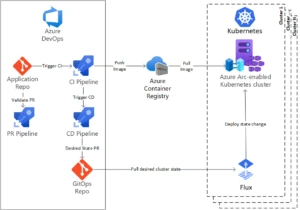AI + Machine Learning, Azure Arc, Azure Kubernetes Service (AKS), Customer stories, Industry trends
Harmonizing AI-enhanced physical and cloud operations
Posted on
7 min read

Azure’s adaptive cloud approach builds on our work with Azure Arc to make it easier for customers to accelerate their adoption of cloud innovation throughout their entire IT estate. In my last blog, I talked about how our adaptive cloud approach unifies siloed teams, distributed sites, and sprawling systems with a collaborative innovation and operations platform—enhanced by AI—across hybrid, multicloud, edge, and IoT. You can accomplish a lot with Azure Arc today, but you will be able to amplify your impact by leveraging AI across existing and new scenarios such as:
- Operating with AI-enhanced central management and security.
- Rapidly developing and scaling applications across boundaries.
- Cultivating data and insights across physical operations.
Customers continue to indicate that building cloud-native apps that can take advantage of data distributed throughout their physical operations will be central to their next digital transformation phase. However, when we work with them to implement these new solutions, the challenges customers face are evident. Issues like legacy applications, heterogeneous environments, fragmented data, and a lack of standardization are slowing their progress. Accordingly, I want to focus on the requirements for the second and third scenarios above.
What is needed, and what we are building in Azure, is a single AI-enhanced operations and innovation platform for developing highly distributed applications that reveal insights and accelerate transformation.
Azure Arc
Secure, develop, and operate infrastructure, apps, and Azure services anywhere.
Turning vision into results
We have learned a great deal about what is needed to bring cloud-native practices, patterns, and approaches into any environment from working with customers, like DICK’s Sporting Goods, who are digitally re-imagining the in-person shopping experience, as well as manufacturers, like Grupo Bimbo, who are creating the factories of the future.
Rapidly develop and scale applications across boundaries
Cloud-native architecture and engineering bring significant benefits to physical operations. To realize these benefits, resources and applications must be tailored to work with physical processes, efficiently managing what workloads run in the public cloud and at operational sites.
By leveraging cloud-native application development patterns everywhere, organizations can focus on creating small, modular, and repeatable component-level investments. These components can be updated frequently, exchanged, and deployed across many environments consistently. This approach helps organizations move away from creating unique solutions for each factory or store by providing a more scalable, standardized foundation for solution development and management.
Drawing inspiration from DICK’s Sporting Goods’ “One Store” vision, the same principle applies: managing, updating, and deploying to each of their 800-plus stores as if they were a single entity. This streamlines DevOps integration and sets a precedent for central application deployment. It establishes a robust foundation for data processing across cloud and edge, with intent to empower decision-making at the edge. This, in turn, boosts efficiency, agility, and sustainability within physical operations. Here is how:

- Microservices architecture breaks down complex systems into smaller, independent services, enhancing agility and ease of updates. For IT and developers, this approach boosts development speed and application updates, and fosters innovation in OT systems. Azure Arc supports this by consistently deploying and managing these microservices across various environments, ensuring flexibility and integration in hybrid landscapes.
- Streamlined DevOps integration emphasizes collaborative and automated workflows that enhance the development lifecycle and significantly reduce the time-to-market for new features and updates. Azure facilitates this through Azure Arc by extending Azure management services to your infrastructure, enabling DevOps practices to be implemented more consistently across hybrid, multicloud, edge, and IoT-heavy environments.
- Central application deployment ensures consistent and efficient application rollouts across the entire network, which is crucial for maintaining a harmonized operational state and reducing deployment variance. Azure Arc integrates with GitOps workflows, allowing for configuration management and application deployment practices to be centralized through Git repositories, which Azure Arc uses to automate updates and maintain consistency across environments.
- Global orchestration and resiliency allows for a coordinated and reliable operation of systems up to an international scale, enhancing the overall uptime and fault tolerance of applications. Adopting CI/CD practices enables continuous updates and improvements. This ensures that systems are up to date with the latest features and security patches, reducing vulnerabilities. Azure Arc brings Azure’s orchestration capabilities to a broader range of environments, providing the tools needed to manage and maintain applications with the same resiliency as in Azure’s native cloud environment.
- Kubernetes everywhere offers scalability and deployment agility through the use of container orchestration to manage applications seamlessly in any environment. Azure Arc enables this by allowing organizations to run Azure services on Kubernetes clusters anywhere, extending Azure’s management capabilities to any infrastructure, and enabling customers to use Azure’s first party Kubernetes service (AKS) to run anywhere.
- Hyperscale cloud services to the edge extend the vast capabilities of cloud computing to local edge devices, optimizing performance and responsiveness, and allowing for real-time data processing and analytics at the source of data generation. Azure Arc supports this by bringing Azure services to the edge, such as AKS, AI/ML, App Service, Functions, Logic Apps, IoT Operations, and more, enabling applications to leverage Azure’s hyperscale capabilities on-premises and in edge environments.
- AI-assisted development and resource management brings a new level of intelligence and automation to cloud environments. By leveraging AI, systems can anticipate needs, optimize resources, and automate routine tasks, to significantly improve efficiency and accuracy. GitHub Copilot helps. Microsoft Copilot for Azure brings AI assistance to operating application resources in the Azure platform, whether they are in Azure regions or connected via Azure Arc.
Cultivate data and insights across physical operations

Physical operations, including production lines, processing facilities, retail locations, medical equipment, and shop floors, are pivotal to an enterprise’s operational framework. These operations are typically spread across several geographically diverse sites, each characterized by distinct equipment types, personnel, and processes. Therefore, enterprises have historically adopted a decentralized model for digitizing their physical operations. This approach involves independent, site-specific strategies for technology integration, application development, and data management.
While this method provides local autonomy, it often leads to inefficiencies and challenges in scaling operations. Extending a cloud-native approach to data is the other critical component for developing highly distributed applications that unlock insights and accelerate transformation.

- Standards-based data flow ensures seamless communication and integration between distributed data, systems, and devices. This means creating interoperable systems that can exchange data effectively for IT, developers, and OT. Azure IoT Operations enables secure and standardized communication between IoT devices, helping maintain consistent and efficient data flow. Additionally, Microsoft’s existing library of connectors to line-of-business applications allows use of Microsoft Fabric’s data factory tools to manage data from multiple sources, like support for use in Fabric’s data lake.
- Common data foundation provides unified data management across diverse environments, which is key for consistency and reliability in analytics and decision-making. This foundation is valuable because it eliminates data silos, allowing for comprehensive insights and better data governance. With Azure Arc, companies can extend Azure data services and tools to most infrastructure, ensuring a consistent data estate spanning on-premises, multi-cloud, and edge environments. Azure IoT Operations, which is built in a way that is open and extensible, leverages open source standards and specifications, including MQTT, OPC UA, Open Telemetry, Akri, and Kubernetes, simplifying integration across a customer’s solution ecosystem and their existing infrastructure. It enables a cloud-to-edge data plane with local data processing and analytics to transfer enhanced, useful data to hyperscale cloud services such as Microsoft Fabric, Azure Event Grid, and Azure Digital Twins. A common data foundation is key to make your data more available, enable cross-team collaboration, and accelerate decision-making.
- Decentralized decision-making enhances responsiveness and reduces latency, which is vital in dynamic operational environments. In IT and OT, the ability to respond faster to operational signals in near real time, without reliance on centralized control systems is often preferred. Azure and Azure IoT Operations support this by enabling edge computing, where operational decisions are made closer to the data source. Azure Arc helps by managing resources in a distributed manner across various locations while making access to information available to all stakeholders from a central, single source of truth.
- Contextualized data to information transforms raw data into easily referenced information and is important for making informed operational decisions. Azure Arc adds value because you can bridge data sources running anywhere, facilitating the integration of local data points with data in the cloud, like supply chain information or customer order data. Then, you can use shortcuts in Microsoft OneLake, within Microsoft Fabric, to unify your data across domains, clouds, and accounts by creating a single virtual data lake for your entire enterprise. This is possible because Azure Arc allows for creating data pipelines so that data aggregations from multiple factories, clinics, or stores can be brought into OneLake.
Going forward
While we witnessed a surge in cloud adoption for IT infrastructures over the past decade, signals indicate the next decade will be a transformative era: building applications that are designed to be distributed across public cloud and operational environments with a set of consistent AI-enhanced services that run anywhere. From brick-and-mortar facilities to supply chains, all the way through personnel and services, cloud-native technology and practices will become the enabler of transformation and will be woven into the physical operations of every organization.
As we navigate this transformative landscape, the call to action for technical leaders is clear: embrace the adaptive cloud approach to act on the changing digital landscape and actively shape it. To get started, bookmark the Azure Arc Jumpstart page. We have ready-to-go environments that you can evaluate and spin up easily, without the work of creating a complex hybrid infrastructure just to test things out.